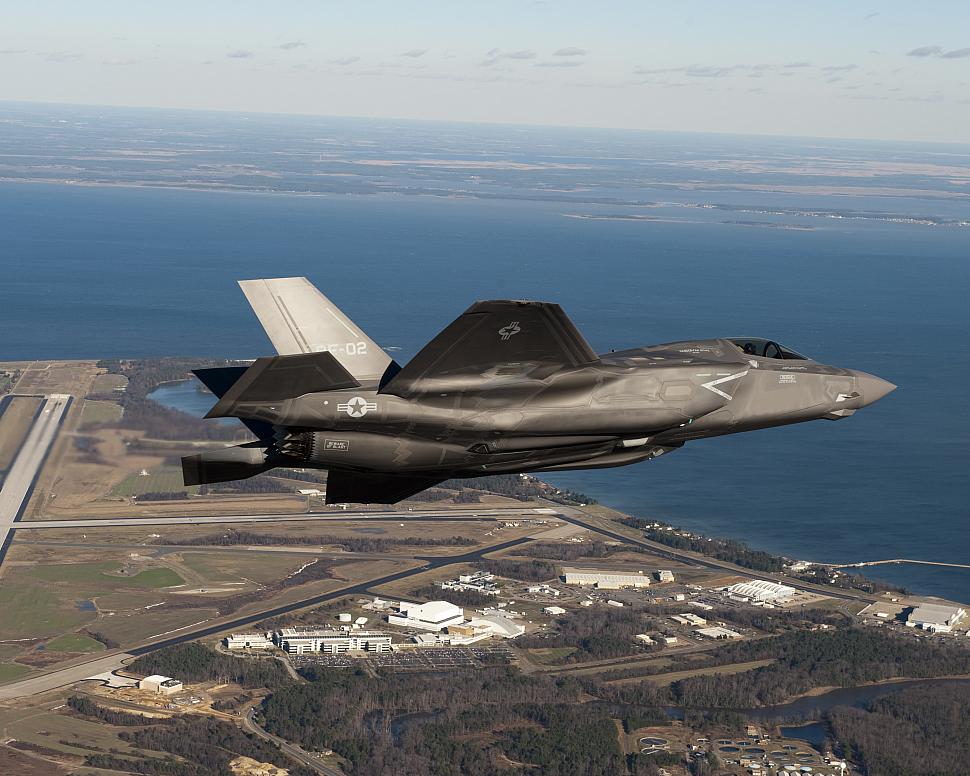Fighter Jet News
F-35 Lightning II News
Marine Corps F-35 goes supersonic
June 14, 2010 (by
John R. Kent) -
F-35 Joint Strike Fighter short takeoff/vertical landing (STOVL) variant flew faster than the speed of sound for the first time June 10, achieving a significant milestone.

The aircraft accelerated to Mach 1.07 (727 miles per hour) on the first in a long series of planned supersonic flights.
"For the first time in military aviation history, supersonic, radar-evading stealth comes with short takeoff/vertical landing capability," said Bob Price, Lockheed Martin's F-35 U.S. Marine Corps program manager. "The supersonic F-35B can deploy from small ships and austere bases near front-line combat zones, greatly enhancing combat air support with higher sortie-generation rates." The F-35B will enter service for the Marines, the United Kingdom's Royal Air Force and Royal Navy, and the Italian Air Force and Navy.
The supersonic milestone was achieved on the 30th flight of the F-35B known as BF-2. U.S. Marine Corps pilot Lt. Col. Matt Kelly climbed to 30,000 feet and accelerated to Mach 1.07 in the off-shore supersonic test track near Naval Air Station Patuxent River. Future testing will gradually expand the flight envelope out to the aircraft's top speed of Mach 1.6, which the F-35 is designed to achieve with a full internal weapons load of more than 3,000 pounds. All F-35s are designed to launch internal missiles at maximum supersonic speed, as well as launch internal guided bombs supersonically. During the flight, Kelly accomplished 21 unique test points, including several Integrated Test Blocks to validate roll, pitch, yaw and propulsion performance.
BF-2 is the third F-35 to achieve supersonic flight. Two F-35A conventional takeoff and landing variants also have broken the sound barrier.
Three F-35 variants are under development – the F-35A CTOL variant to replace U.S. Air Force F-16s and A-10s, as well as aircraft employed by seven allied nations; the F-35B STOVL variant to replace U.S. Marine Corps AV-8B Harriers and F/A-18s, U.K. Royal Air Force and Royal Navy Harrier GR.7s, GR.9s and Sea Harriers, and Italian Harriers; and the F-35C carrier variant to replace U.S. Navy F/A-18s.

The second F-35B Lightning II (BF-2) short take-off/vertical landing (STOVL) stealth fighter arrived today at NAS Patuxent River. [LM photo]
"For the first time in military aviation history, supersonic, radar-evading stealth comes with short takeoff/vertical landing capability," said Bob Price, Lockheed Martin's F-35 U.S. Marine Corps program manager. "The supersonic F-35B can deploy from small ships and austere bases near front-line combat zones, greatly enhancing combat air support with higher sortie-generation rates." The F-35B will enter service for the Marines, the United Kingdom's Royal Air Force and Royal Navy, and the Italian Air Force and Navy.
The supersonic milestone was achieved on the 30th flight of the F-35B known as BF-2. U.S. Marine Corps pilot Lt. Col. Matt Kelly climbed to 30,000 feet and accelerated to Mach 1.07 in the off-shore supersonic test track near Naval Air Station Patuxent River. Future testing will gradually expand the flight envelope out to the aircraft's top speed of Mach 1.6, which the F-35 is designed to achieve with a full internal weapons load of more than 3,000 pounds. All F-35s are designed to launch internal missiles at maximum supersonic speed, as well as launch internal guided bombs supersonically. During the flight, Kelly accomplished 21 unique test points, including several Integrated Test Blocks to validate roll, pitch, yaw and propulsion performance.
BF-2 is the third F-35 to achieve supersonic flight. Two F-35A conventional takeoff and landing variants also have broken the sound barrier.
Three F-35 variants are under development – the F-35A CTOL variant to replace U.S. Air Force F-16s and A-10s, as well as aircraft employed by seven allied nations; the F-35B STOVL variant to replace U.S. Marine Corps AV-8B Harriers and F/A-18s, U.K. Royal Air Force and Royal Navy Harrier GR.7s, GR.9s and Sea Harriers, and Italian Harriers; and the F-35C carrier variant to replace U.S. Navy F/A-18s.
Courtesy of Lockheed Martin
